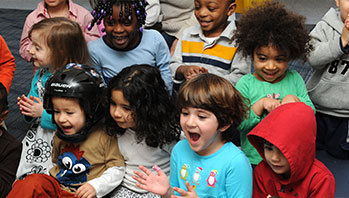- high
- low
MA Standards:
Speaking and Listening: SL.PK.MA.1a Observe and use appropriate ways of interacting in a group (e.g., taking turns in talking, listening to peers, waiting to speak until another person is finished talking, asking questions and waiting for an answer, gaining the floor in appropriate ways).
MA Draft STE Standards:
Physical Sciences/Energy and PS4.B Apply their understanding in their play of how to change volume and pitch of some sounds.
Head Start Outcomes:
Social Emotional Development/Self-Regulation Follows simple rules, routines, and directions.
Language Development/Receptive Language Attends to language during conversations, songs, stories, or other learning experiences.
PreK Learning Guidelines:
English Language Arts/Language 1 Observe and use appropriate ways of interacting in a group (taking turns in talking; listening to peers; waiting until someone is finished; asking questions and waiting for an answer; gaining the floor in appropriate ways).
English Language Arts/Reading and Literature 12 Listen to, recite, sing, and dramatize a variety of age-appropriate literature.
Greeting Song: “Try, Try, Try To Sing” #2

© Commonwealth of Massachusetts, Department of Early Education and Care (Jennifer Waddell photographer). All rights reserved.
STEM Key Concepts: Sounds can vary in pitch (high or low)
ELA Focus Skills: Speaking and Listeneing, Phonological Awareness, Vocabulary
Sing "Try, Try, Try to Sing" to children again and change the pitch of your voice for each verse.
Sing the song again and have children sing the song with you as you repeat the same pitch changes. Then go around in a circle and have each child (or volunteers, if you have a large group) call out "High pitch!" or "Low pitch!" Have the group sing while changing the pitch each verse.
Try, Try, Try to Sing
(sung to the tune of “Row, Row, Row Your Boat)
Try, try, try to sing,
Try and try again.
If at first you don’t succeed,
Wish and try again.
Try, try, try to sing,
Practice every day.
If at first you don’t succeed,
Keep trying and you may.
